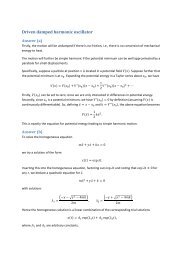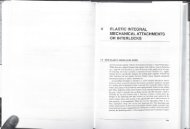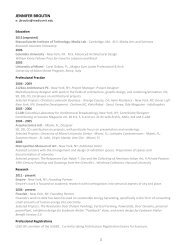Snap-Fit Joints for Plastics - A Design Guide - MIT
Snap-Fit Joints for Plastics - A Design Guide - MIT
Snap-Fit Joints for Plastics - A Design Guide - MIT
Create successful ePaper yourself
Turn your PDF publications into a flip-book with our unique Google optimized e-Paper software.
Cantilever <strong>Snap</strong> <strong>Joints</strong> B<br />
<strong>Design</strong> Hints<br />
A large proportion of snap joints are basically<br />
simple cantilever snaps (Fig. 8), which may be<br />
of rectangular or of a geometrically more<br />
complex cross section (see Table 1).<br />
It is suggested to design the finger so that<br />
either its thickness (h) or width (b) tapers from<br />
the root to the hook; in this way the load-bearing<br />
cross section at any point bears a more<br />
appropriate relation to the local load. The<br />
maximum strain on the material can there<strong>for</strong>e<br />
be reduced, and less material is needed.<br />
Good results have been obtained by reducing<br />
the thickness (h) of the cantilever linearly so<br />
that its value at the end of the hook is equal to<br />
one-half the value at the root; alternatively, the<br />
finger width may be reduced to one-quarter of<br />
the base value (see Table 1, designs 2 and 3).<br />
With the designs illustrated in Table 1, the vulnerable<br />
cross section is always at the root (see<br />
also Fig. 8, Detail A). Special attention must<br />
there<strong>for</strong>e be given to this area to avoid stress<br />
concentration.<br />
Fig. 9 graphically represents the effect the root<br />
radius has on stress concentration. At first<br />
glance, it seems that an optimum reduction in<br />
stress concentration is obtained using the ratio<br />
R/h as 0.6 since only a marginal reduction<br />
occurs after this point. However, using R/h of<br />
0.6 would result in a thick area at the intersection<br />
of the snap-fit arm and its base. Thick sections<br />
will usually result in sinks and/or voids<br />
which are signs of high residual stress. For this<br />
reason, the designer should reach a compromise<br />
between a large radius to reduce stress<br />
concentration and a small radius to reduce the<br />
potential <strong>for</strong> residual stresses due to the creation<br />
of a thick sec-tion adjacent to a thin section.<br />
Internal testing shows that the radius<br />
should not be less than 0.015 in. in any<br />
instance.<br />
Fig. 8: Simple snap-fitting hook<br />
Fig. 9: Effects of a fillet radius on stress concentration<br />
Page 8 of 26 <strong>Snap</strong>-<strong>Fit</strong> <strong>Joints</strong> <strong>for</strong> <strong>Plastics</strong> - A <strong>Design</strong> <strong>Guide</strong><br />
9





